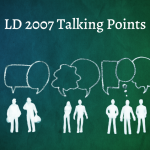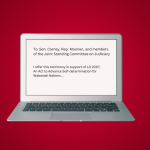Letters the editor, also called LTEs, can be a powerful way to persuade legislators to pass LD 2007, a bill to restore the inherent right of the Wabanaki Nations in Maine to self-govern within their respective territories in accordance with the same federal laws that generally govern tribal lands elsewhere in the United States. If you’ve never written an LTE before, don’t worry. Writing LTEs is how many people take their first steps into action on issues they care about. Get started with the tips below.
- Learn about the issue. Before you can write a persuasive LTE, you should learn about the issue. You can learn more about LD 2007, An Act to Advance Self-Determination for Wabanaki Nations, in our Talking Points and Frequently Asked Questions (FAQ).
- Keep it short. Shorter letters are most effective and most newspapers limit LTEs to around 250 words. Get to your point quickly and put your best material up top. If your letter is edited it’s likely to be from the bottom up.
- Tell your story. This is absolutely the most important thing! Begin with a brief story about you or someone you know. People can argue with your positions, but they can’t argue with your experience. Why is restoring tribal sovereignty to the Wabanaki Nations important to you? How might LD 2007 benefit you, your family, your community, a coworker or a friend. Make it personal.
- Don’t delve into policy. There isn’t enough room in 250 words to make a nuanced policy argument. When using facts and numbers, use only one or two, and choose the most powerful. A long string of facts and information is not an argument.
- Include sources. Most newspapers publish LTEs on their website and encourage writers to include links to sources for statistics, facts, and arguments included in the letter. Don’t make arguments that you can’t back up with facts.
- Use powerful language. Let your feelings show! Use powerful verbs and descriptive nouns. Write short, punchy sentences. Vary sentence length. This will help your letter stand out and make it more likely to be published.
- Make a call to action. End your letter by asking your lawmakers to vote YES on LD 2007, prompting community members to voice their support, or some other call to action to support this bill. Your LTE will only be effective if it gets others to act!
- LTE or guest editorial? Maine’s large daily newspapers also run guest editorials that vary in length from 600-800 words. Those with notable expertise on an issue or who are writing on behalf of a group are good candidates for guest editorials. Send an email query to the editorial page editor to gauge interest before submitting.
- Still not sure where to start? Check out our LD 2007 Talking Points on the bill to get you going. And take a look and some published LTEs by other Mainers published in the Forecaster and Bangor Daily News. If you’re thinking of submitting a guest editorial, take a look at this one from the Portland Press Herald as a good example.
- Check and sign your letter. Do a final check for proper grammar and spelling. Write your full name (and title, if relevant) and include your address, phone number, and e-mail address. Newspapers won’t print anonymous letters, though in some cases they may withhold your name on request. They may also call you to confirm that you wrote the letter before they publish it.
- Submit your letter. You should submit your letter to one paper only, so decide which is the best choice for you. If you live in a part of Maine where this is a “local” issue that might be your hometown paper; otherwise, it would likely be one of the larger dailies. Wabanaki Alliance Coalition member organization Natural Resources Council of Maine maintains a list with contact information for Maine newspapers. Find it here.
- Share your published LTE! When your letter is published, share it widely on social media and via email with your friends, family, and networks — and with us! We’ll highlight LTEs on our social media channels on this website. Send the link to us at info@wabanakialliance.com. And be sure to share it with your legislators as well. Visit our Contact Your Legislators guide for more info.







